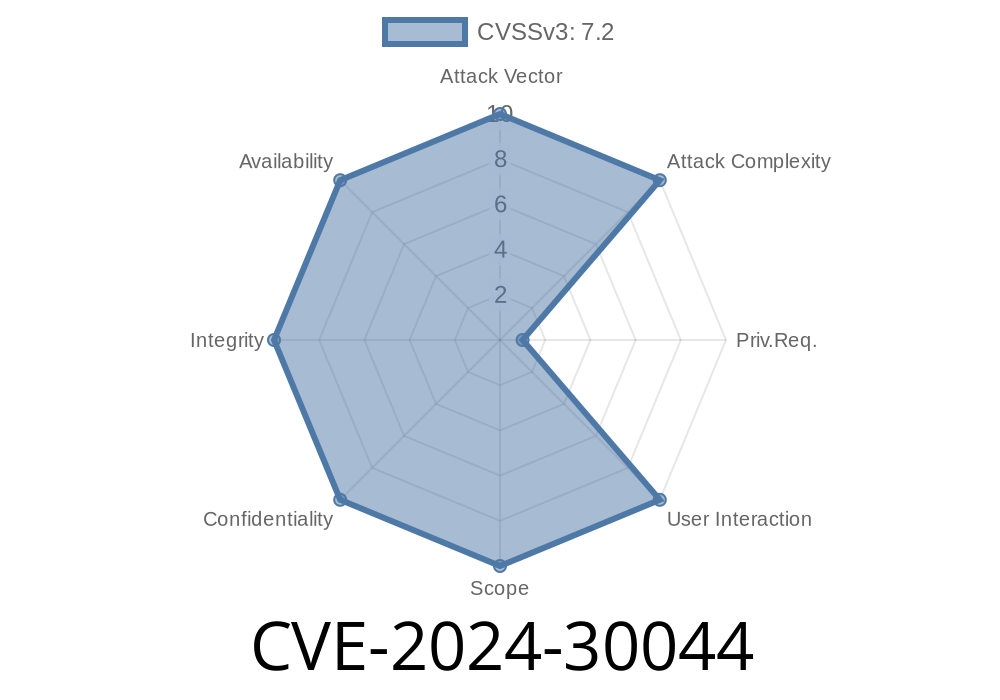CVE-2024-30044 is a high-severity vulnerability that affects Microsoft SharePoint Server, potentially allowing remote attackers to execute arbitrary code on vulnerable systems. This post will break down what this bug is, how it works, and how attackers might exploit it. I’ll also share simple code snippets and key links for those looking to dig deeper.
What is CVE-2024-30044?
This vulnerability was officially published in Microsoft’s security advisory and confirmed on Patch Tuesday, June 11, 2024. The flaw impacts:
SharePoint Server Subscription Edition
- SharePoint Server 2016/2019
It’s classified as a *Remote Code Execution* (RCE) bug, meaning that an unauthenticated attacker with network access can run code of their choice on the server.
Attacker does not need direct system access, just network ability to reach the SharePoint server.
- Successful exploitation means the attacker could read, modify, or delete data; or plant backdoors in your network.
How Does CVE-2024-30044 Work?
The vulnerability exists due to improper input validation in SharePoint’s web interface. Malicious content uploaded or crafted requests can trick the server into deserializing attacker-supplied data, leading to code execution.
According to Microsoft's CVSS scoring, the attack complexity is low, making it easier to exploit even by less-skilled attackers.
Exploit Path and Code Example
NOTE: Only run proof-of-concept (PoC) code in a lab, not in production.
The request abuses file upload or workflow functions, injecting dangerous serialized objects.
- If successful, attacker commands execute on the SharePoint server in the context of the web application.
PoC Exploit Snippet (Python Example)
The following is a simplified, educational demonstration. In practice, exploit payloads would be more complex:
import requests
sharepoint_url = "http://vulnerable-sharepoint/_layouts/15/Workflow.aspx";
malicious_payload = "<ObjectData><Binary>base64encoded-malicious-code</Binary></ObjectData>"
headers = {
'Content-Type': 'application/xml',
}
response = requests.post(sharepoint_url, data=malicious_payload, headers=headers)
print("Status code:", response.status_code)
print("Response:", response.text)
In real exploits, attackers would craft the payload using tools like ysoserial.net to generate .NET serialization objects carrying the code to be executed on the server.
Apply Security Updates: Microsoft released a fix—patch as soon as possible!
- Microsoft Patch Guide for CVE-2024-30044
Microsoft Security Update:
CVE-2024-30044 Official Advisory
- NVD Details on CVE-2024-30044
ysoserial.net for .NET gadget chains:
https://github.com/pwntester/ysoserial.net
- Microsoft SharePoint Security Blog
Conclusion
CVE-2024-30044 is a good reminder that web-facing business servers like SharePoint remain lucrative targets for attackers. The path to exploit is not overly complicated, and unpatched servers are at serious risk. Defenders should patch immediately and monitor their environments for suspicious activity—especially unauthorized file uploads and workflow executions.
Stay informed, stay patched, and always test security changes in a safe environment first.
Timeline
Published on: 05/14/2024 17:17:16 UTC
Last modified on: 06/19/2024 20:58:34 UTC
